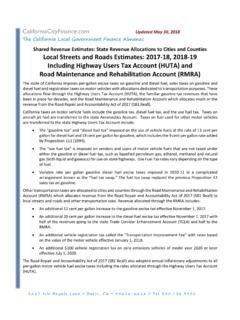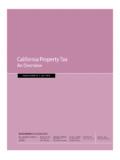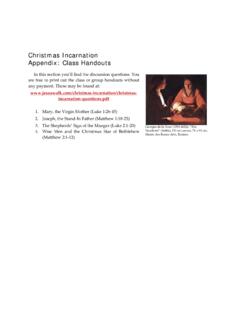Transcription of Proposition 172 Facts - CaliforniaCityFinance.com: The ...
1 Coleman Advisory S ervices Proposition 172 Facts A Primer on the Public Safety Augmentation Fund Background: A Sales Tax for Public Safety Born Out of ERAF In 1992, facing serious budget deficits, the California Legislature and Governor Wilson instructed county auditors to shift the allocation of local property tax revenues from local government to educational revenue augmentation funds (ERAFs), directing that specified amounts of city, county and other local agency property taxes be deposited into these funds to support schools. School funding from the state general fund was reduced by a commensurate amount.
2 To cushion the impact of the ERAF shifts, the California Legislature and Governor Wilson submitted to the voters a proposal for a new half cent sales tax to be dedicated to local public safety including sheriff, police, fire, county district attorneys, and corrections. Proposition 172, the Local Public Safety Protection and Improvement Act of 1993, was approved by 58% of the voters. The Proposition 172 half-cent sales tax actually replaced a prior half-cent sales tax for public safety imposed by the Legislature and Governor Wilson for the 2003 year. That sales tax, also intended as a mitigation for ERAF, replaced a half-cent state sales tax for earthquake insurance.
3 Consequently, taxpayers saw no net increase in their overall tax burden from Proposition 172. What Public Safety Services Can Proposition 172 Be Spent On? A city or county that receives Proposition 172 funds must place the revenues in a special revenue fund to be expended only on public safety services as defined in Government Code Section 30052. Eligible services include sheriffs, police, fire, county district attorneys, corrections and ocean Government Code Section 30056 contains maintenance of effort provisions concerning Proposition 172 funds requiring cities and counties to maintain funding levels to public safety functions which receive Proposition 172 funds.
4 These provisions ensure that Proposition 172 funds are spent on public safety services as defined. Allocation of Proposition 1722 The one-half cent sales tax imposed by Proposition 172 is collected by the State Board of Equalization and apportioned to each county based on its proportionate share of statewide taxable sales. Each county is required to deposit this revenue in a Public Safety Augmentation Fund to be allocated by the County Auditor to the county and cities within the county. Mindful of the substantially larger proportion of ERAF paid statewide by counties than by cities or special districts, legislative leaders initially considered allocating all Proposition 172 proceeds to counties only.
5 But they realized the success of Proposition 172 with the voters would be enhanced with the support of city officials, police and fire chiefs, police officers and city firefighters, so a portion was allocated to cities. Government Code Section 30051 requires each County Auditor to allocate the revenues in the county Public Safety Augmentation Fund (PSAF) to the county and each city in that county based on their proportionate share of net property tax loss due to ERAF as defined. For the purposes of allocating PSAF revenue, an agency s net property tax loss is defined as the that agency s 1993-94 property tax loss due to phase II of ERAF, reduced by that agency s 1993-94 one-time receipt of funds from the Transportation Planning and Development Account.
6 1 Government Code Section 30052 2 Government Code Section 30051 et seq. 2217 ISLE ROYALE LANE DAVIS, CA 95616-6616 PH/FAX: 2 Updated October 2006 2 Phase II of ERAF3, which began in 1993-94 is based on each agency s estimated receipt of property tax revenues under AB8 of 1980. Cities that received no property tax or that did not exist in 1980 are not affected by this phase of ERAF and consequently are ineligible for Proposition 172 revenues. The law provides nine counties with unique allocation formulas. These unique formulas are the result of special circumstances and negotiated compromises.
7 These exception counties are: Fresno, Kings, Merced, San Bernardino, San Joaquin, Solano, Yolo (Gov Code Sec 30055(b)) Alameda (Gov Code Sec 30055(c)) San Diego (Gov Code Sec 30055(d)) Cities in San Diego County initially had their allocation capped at 5% under the same provision that still affects cities in Fresno, Kings, Merced, San Bernardino, San Joaquin, Solano, and Yolo counties. In 1996, cities in the San Diego County sought to get out from this cap. Under a compromise solution, reluctantly supported by the County of San Diego, the cities and the professional firefighters,4 a new, special code section was adopted with allocation factors for San Diego County and cities that were calculated to match the factors that would apply under the section that applies to most other Thus, the Proposition 172 allocations in San Diego County today effectively treat the county and cities the same as most others in the state.
8 How Much Mitigation Does Proposition 172 Provide For ERAF? Cities contribute 14% of ERAF funds, counties 77%, and special districts 7% annually (see Chart 2A). Proposition 172 mitigates about 19% of the annual statewide ERAF property tax loss for cities, about 61% of the statewide ERAF losses of counties (see Chart 2B). But Proposition 172 allocations do not mirror ERAF property tax shifts. Local agencies vary in the degree to which Proposition 172 compensates for ERAF property tax loss. Individual agency losses to the ERAF property tax shifts are primarily related to property tax revenues received by each agency in the post- Proposition 13 property tax shift often referred to as the AB8 bailout.
9 6 Proposition 172 allocations depend primarily on the volume of taxable sales occurring in each county. Within each county Proposition 172 allocations are allocated to cities and the county based on a part of the ERAF shift. Because the intent of Proposition 172 has always been to mitigate the impacts of the ERAF property tax shifts on public safety services, cities that were not impacted by this phase of the shift do not receive Proposition 172 revenues. For a complete listing of Proposition 172 allocations for all cities and counties see Net Impact of ERAF, Prop 172 and COPs at mjgc 3 Revenue and Taxation Code Section 4 The policy committee analyses of SB8 (1996) lists all these as supporters.
10 5 This reduced the county s share from 95% to and adjusted the collective share to cities from 5% to The San Diego County Auditor estimated this change cost the county $848,000 in 1996-97. In FY05-06 the effect is roughly $ million. 6 AB8 (Greene) Statutes of 1980 3 Updated October 2006 3 Fast Facts on Proposition 172 The purpose of Proposition 172 was not necessarily to increase public safety funding, but to maintain public safety funding levels in spite of ERAF property tax shifts. Counties, the primary losers under ERAF, were the primary recipients of Proposition 172. Fire and police special districts receive no Proposition 172 funding because they are virtually exempt from ERAF.










